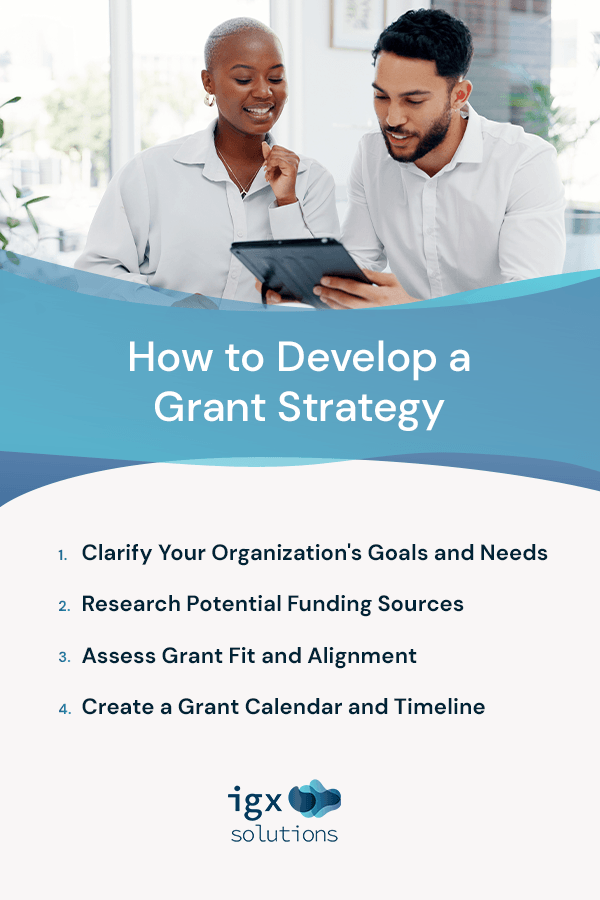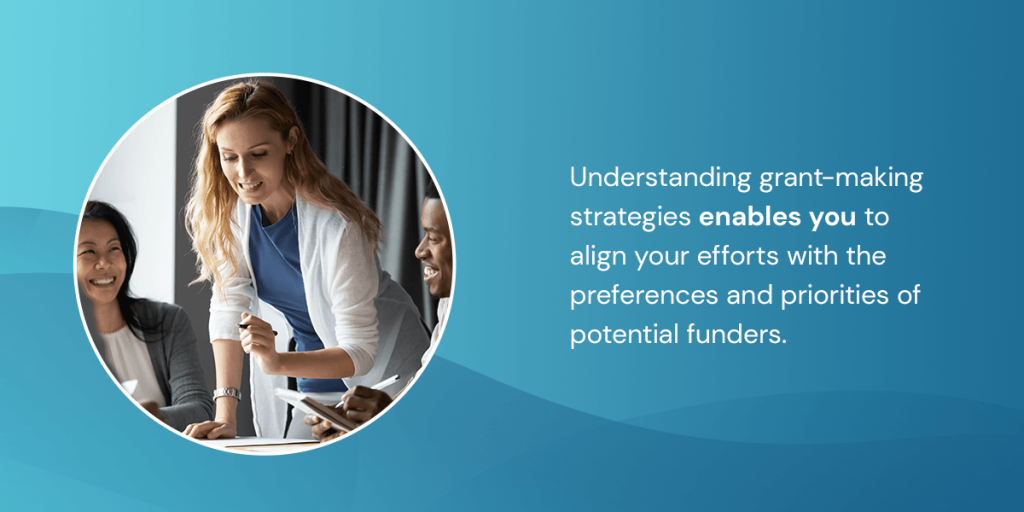
Jump to Content
Obtaining grants can be a transformative opportunity for organizations and individuals looking to fund their projects and initiatives. Applying for a grant is highly competitive, but strategic program planning can increase the likelihood of success.
This article provides valuable tips and strategies for grant seekers to enhance their project plan for the grant application process. By understanding and implementing these tips, you can optimize your chances of securing funding for your projects and positively impacting your community.
Developing a grant strategy is crucial for individuals and organizations seeking funding through grants. A well-defined grant strategy streamlines the process, increases efficiency, and maximizes the chances of securing funding. Here are several reasons why developing a grant strategy is essential:

By taking a strategic approach, grant seekers with awarding strategies can enhance their chances of securing funding, maximize their impact, and achieve their goals more effectively.
Developing a grant strategy involves several key steps to ensure a well-defined and effective approach to securing funding. Here is a step-by-step guide on how to develop a grant strategy:

When developing a grant strategy, you must first clarify your organization’s goals and needs. This step helps ensure your grant-seeking efforts align with your overall mission and objectives. Here are some key points to consider:
Start by clearly defining your organization’s mission and vision. Understanding your mission and vision will provide a foundation for identifying grants that support your organization’s core purpose.
These objectives outline the specific outcomes you want to achieve and the areas of focus for your programs or initiatives. Consider the social, environmental, or community impact you aim to make. Aligning your grant-seeking efforts with these objectives will help you find grants that are most relevant to your organization’s work.
Assess the specific needs of your projects or programs that require funding. Identify the gaps that need to be filled, whether it’s funding for new projects, capacity-building efforts, equipment, research, or community outreach. Understanding your needs will guide you in targeting grants that can address those gaps.
Grants can provide valuable financial support, but ensuring your grant strategy aligns with your broader sustainability plan is important. Explore grants that provide funding for immediate needs and contribute to your organization’s long-term growth and stability.
Determine if there are potential synergies with other organizations or stakeholders that can enhance your project’s impact or increase your chances of securing grants. Collaboration can also provide access to new funding opportunities and expand your network within the grant-seeking landscape.
Grantors often require reporting on the progress and results achieved through their funding. Ensure that your grant strategy includes plans for monitoring and evaluation, including data collection, reporting mechanisms, and performance indicators aligned with your organization’s goals.
By clarifying your organization’s goals and needs, you establish a solid foundation for developing a grant strategy that aligns with your mission, addresses your specific project or program requirements, and contributes to your long-term sustainability. This clarity will help you identify the most suitable grants to pursue and increase your chances of securing funding that aligns with your organization’s objectives.
Researching potential funding sources is a critical step in developing a grant strategy. It helps identify grant opportunities that align with your organization’s mission, projects, and funding needs. Here are some potential funding sources:
Explore local, state, and federal government agencies offering grants related to your focus areas. Visit their websites or contact their grant offices to understand their funding priorities, application processes, and eligibility criteria.
Many foundations have specific areas of interest or target populations they support. Look for foundations that have funded similar organizations or projects in the past. Review their guidelines and application procedures, which are typically available on their websites.
These programs often support initiatives aligned with their corporate social responsibility goals. Look for companies in your industry or those with a history of supporting organizations similar to yours. Check their websites or contact their corporate social responsibility departments for information on grant opportunities.
Websites such as Foundation Directory Online, GrantWatch, or GrantStation provide comprehensive databases with various grant options. To refine your search, use search filters based on your focus areas, geographic location, and organization type.
These groups often share information about grant opportunities with their members or have resources to support grant-seeking efforts. Attend conferences, webinars, or workshops related to your sector to connect with experts and learn about potential funding sources.
These entities may offer grants specifically targeted at community development, education or social services. Reach out to local chambers of commerce, nonprofit resource centers or community development offices for information on available grants.
Sign up for newsletters, email alerts, or RSS feeds from grant-related websites and organizations. These resources often provide regular updates on new funding opportunities, application deadlines and grant-related news.
Consider engaging professional grant writers or consultants specializing in your industry or sector. They can provide expertise and help identify suitable funding sources based on their knowledge and experience.
Remember to maintain a comprehensive list or database of potential funding sources, including contact information, application deadlines and requirements. Regularly review and update your research to stay informed about new grant opportunities or changes in funding priorities.
Assessing grant fit and alignment is crucial in developing a grant strategy. It ensures that the grants you pursue are well-suited to your organization’s mission, goals and project needs. Here are some key considerations to assess grant fit and alignment:
Review the grantor’s mission and values to ensure they align with yours. Look for explicit statements or indicators of compatibility between the grantor’s funding priorities and your organization’s purpose and focus areas.
Evaluate how closely the grant opportunity aligns with your organization’s programs or specific project objectives. It’s best if the grant supports the same target population, geographic area or issue that your organization aims to address. Consider whether the grant will contribute to advancing your project goals and objectives.
Carefully review the grant’s eligibility criteria to determine if your organization qualifies to apply. The grantor may have restrictions related to organization size, legal status, geographic location or specific project requirements. Ensure that your organization meets all criteria before proceeding with the application process.
Investigate the grantor’s funding priorities and preferences. Analyzing past grants they have awarded can give you insights into the types of projects they support. You’ll want to consider if their funding priorities align with your organization’s needs and if your project can clearly demonstrate how it meets their specific interests and goals.
Assess if the grant amount and duration align with your organization’s funding needs and project timeline. Consider if the funding provided is adequate to cover project expenses, including direct costs, overhead and evaluation or reporting requirements. The grant’s timeline should align with your project’s implementation plan and any anticipated milestones.
Evaluate the grant’s reporting and compliance expectations. You’ll want to ensure your organization has the capacity and resources to fulfill the reporting and documentation requirements specified by the grantor. Determine the level of monitoring, evaluation or financial reporting needed and whether your organization can meet those obligations.
Research the grantor’s track record and reputation in the funding community. You should consider factors such as their history of supporting projects similar to yours, the outcomes achieved by their grantees and the experiences of organizations that have received their funding. Assess the grantor’s credibility, accountability and responsiveness to determine if they align with your organization’s values and expectations.
One of the first things you learn when applying for grants is that the application and approval process can take months or even a year to go through. Furthermore, you’ll likely be applying to multiple grants at a time. For many organizations, having a calendar or timeline is crucial in staying on track and ensuring you allocate sufficient time for proposal development and submission. Here’s a step-by-step guide to creating a grant calendar and timeline:
Consider seeking grants that align with your organization’s mission, projects, and funding needs. This stage can take as long as you want it to — you may find the perfect grant opportunity within a day, or you may spend months searching for the right option.
As you find standout opportunities, collect detailed information along the way, including requirements, deadlines, funding amounts and any special documentation you’ll need for the application. Using a tool like a grant management system can be especially helpful in keeping this information in order, but a spreadsheet can work, too.
Now that you’ve started narrowing down your options, look closely at what each one offers and rank them in order of importance to your organization’s strategy. You’ll want to consider factors such as the funding amount, relevance to your organization’s goals and the project’s potential impact.
As you start your applications in earnest, make the job a little easier for yourself by breaking it down into digestible chunks.In most cases, you’ll start your application months before the deadline, so you can give your organization adequate time to do research, draft your proposal and collect all your materials. Be sure to consider how much you can reasonably contribute to each section during different times in your organization’s life cycle so you can avoid pitfalls.
Clearly mark the application deadlines for each grant on your calendar. Be mindful of any early submission requirements or specific time zones to ensure you submit the applications on time. Note any interim deadlines, such as pre-proposal inquiries or letters of intent, if applicable.
Grant writing is a specialty field for a reason. Be sure you give your organization enough time to develop each proposal, especially if applications require collaboration or extensive research. Allocate ample time to write, review, revise and polish the proposal before submission.
When you set milestones for your application, allot more time than you think you may need for review. Give your colleagues time to read over the proposal and offer their thoughts. Setting aside at least a few weeks for this back-and-forth ensures you have time to look over their notes and adjust your proposal as needed.
Determine the resources needed for each grant application, including staff time, expertise, research materials and budget planning. You may also require external assistance, such as professional grant writers or consultants.
Make it a point with your organization to implement regular reviews to ensure you’re staying on track. If not, these reviews give you a chance to reconsider your processes and update your to-do lists. As you track your progress against milestones and deadlines, make adjustments as needed, considering any changes in grant requirements, additional funding opportunities or shifts in your organization’s priorities.
Even after you submit your applications, your work is not done. Anticipate post-award requirements, such as reporting, evaluation or ongoing project updates. Note these deadlines and plan accordingly to ensure compliance and effective grant management if the grant is awarded.
By following these steps, your organization can develop a robust grant strategy that aligns with your goals, maximizes your chances of success, and supports your long-term sustainability.
Grant-making strategies refer to the approaches and considerations used by grant-making foundations to distribute funds to recipients. Understanding the following four strategies can help your organization allocate funds effectively and maximize your impact:
This strategy focuses on meeting the immediate needs of organizations and communities. It involves reviewing grant applications and allocating funds to projects that align with the foundation’s mission and meet specific criteria.
Proactive grant-making takes a proactive approach to identifying and addressing emerging or future needs. This strategy involves actively engaging with stakeholders, conducting research, and staying informed about trends and developments in the social sector.
Strategic grant-making involves a more deliberate and planned approach. It aims to address underlying issues or root causes of social problems. This strategy is typically used to conduct research and analysis to identify key focus areas and develop a long-term plan for grant-making activities.
Collaborative grant-making emphasizes partnerships and collective efforts. Employing this strategy involves collaboration with other funders, nonprofits, and community stakeholders to pool resources, expertise, and networks.

Understanding grant-making strategies enables you to align your efforts with the preferences and priorities of potential funders. Knowing these strategies helps you develop targeted proposals, build relationships with grantmakers, and focus their resources effectively.
You can also incorporate these strategies into your grant-seeking approach to increase your chances of securing funding and achieving your organization’s goals.

Securing grant funding requires a strategic and well-prepared approach. More than that, it involves detailed planning, accounting and communication from the moment you start applying until you’ve fulfilled all terms of the grant.
At IGX Solutions, we can help speed up and adapt the grant-making process through cutting-edge technology and top-market features. Our grant management software will help you track your grants throughout their entire life cycles and prepare detailed reports to keep you and your grantor informed of every milestone and setback. Book a demo today or contact us to learn more about grants for strategic planning.